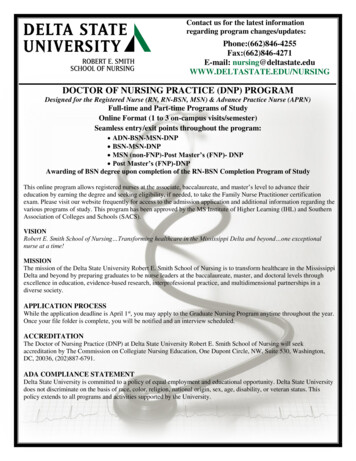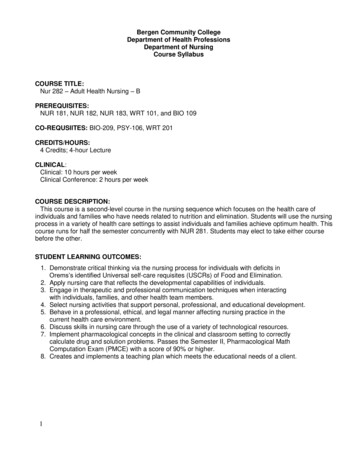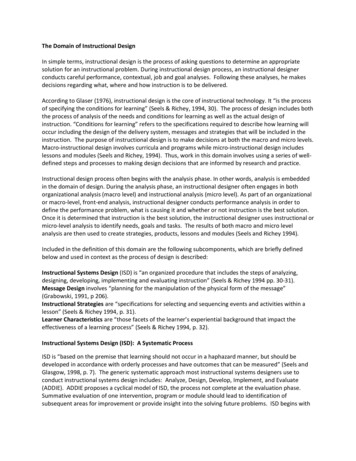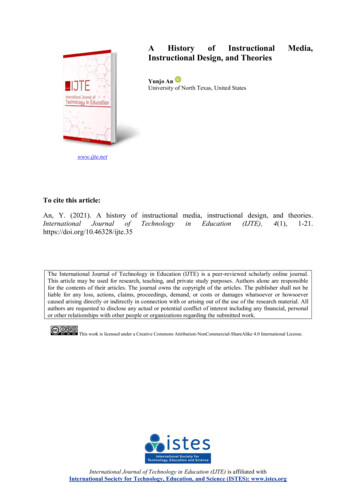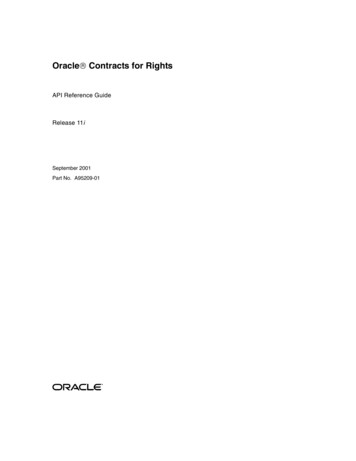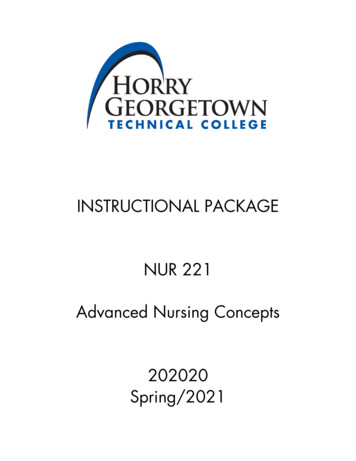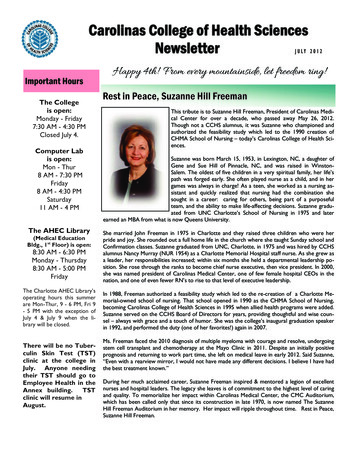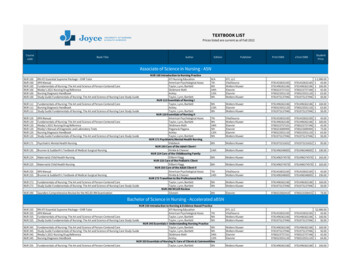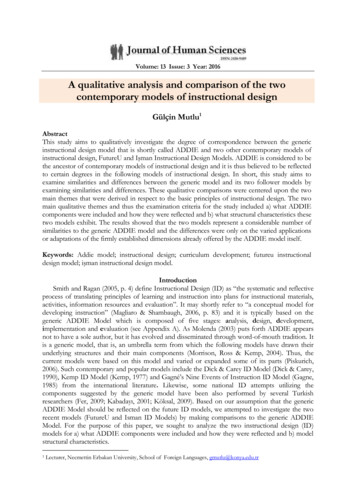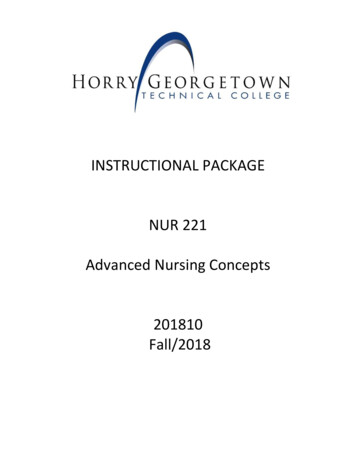
Transcription
INSTRUCTIONAL PACKAGENUR 221Advanced Nursing Concepts201810Fall/2018
INSTRUCTIONAL PACKAGEPART I: COURSE INFORMATIONEffective Term: 201810COURSE PREFIX: NUR 221COURSE TITLE: Advanced Nursing ConceptsCONTACT HOURS: 3 class hoursCREDIT HOURS: 5 hours6 lab hoursRATIONALE FOR THE COURSE:This course prepares the student to care for clients with life -threatening illness in a holistic manner,understand the complexities of multiple comorbidities, meet the psychosocial needs of clients and theirfamilies, provide holistic care to the dying client and increase participation in the profession by involvement indisaster preparedness. The student will be exposed to multiple areas that will reinforce the behaviors inherentin practice as a professional nurse: critical thinking, communication with adaptation to various barriers,professional behavior, and management of client care, teaching/learning, incorporation of evidence basedpractice, clinical competence, and provision of culturally sensitive care.COURSE DESCRIPTION:This course expands the application of the nursing process in the care of persons throughout the life span whoare experiencing complex health problems.PREREQUISITES/CO-REQUISITES:NUR 161NUR 220NUR 217SPC 205Co-requsites:NUR 217SPC 205REQUIRED MATERIALS:Please visit the Bookstore online site for most current textbook information. Use the direct link below to findtextbooks.BOOKSTORE.Enter the semester, course prefix, number and section when prompted and you will be linked to the correcttextbook.ADDITIONAL REQUIREMENTS:Arikian, Veronica. (Ed). (2012). Kaplan Nursing-The Basics.Complete HGTC student nurse’s uniformWristwatch with second handBandage scissorsPenlightStethoscopeJuly 2018 ADA compliant
EKG calipers or measuring cardTECHNICAL REQUIREMENTS:Access to Desire2Learn (D2L), HGTC’s student portal for course materials.WaveNet and D2L email access.CLASSROOM ETIQUETTE:As a matter of courtesy to other students and your professor, please turn off cell phones and othercommunication/entertainment devices before class begins. If you are monitoring for an emergency, pleasenotify your professor prior to class and switch cell phone ringers to vibrate.PART II: STUDENT LEARNING OUTCOMESUpon completion of this capstone course (NUR 221) in the ADN curriculum, the student will beable to:1. SAFETYPromote a culture of safety within health care settings that minimizes the risk of harm to recipients andproviders of nursing care2. CLINICAL DECISION MAKINGFormulate effective clinical decisions, using analytical processes, which promote positive outcomes forrecipients of nursing care3. TEAMWORK AND COLLABORATIONFacilitate coordinated patient care by integrating communication skills with inter-professional collaborativeprocesses4. PROFESSIONAL BEHAVIORSModel behaviors that demonstrate accountability and reflect standards of the profession.5. PATIENT CENTERED CAREManage patient-centered care that values individual rights and needs while respecting diversity.In addition to the above student learning outcomes, the student, upon completion of this course in the fifthsemester of the ADN Curriculum, will be able to:1. Formulate nursing judgments which adhere to the ANA’s Standards of Clinical Practice and the ANA’s Codeof Ethics in providing nursing care to adult clients experiencing acute, complex, and life-threatening healthchanges.2. Utilize the nursing process in the implementation of the three roles of the ADN (provider of care, managerof care, and member within the discipline) in providing nursing care to culturally diverse clients experiencingacute, complex, and life-threatening health changes.3. Apply management strategies to provide cost-effective, safe, and high-quality health care in a variety ofsettings, support beneficial changes, and serve as an advocate for adult clients experiencing acute, complex,and life-threatening health changes.4. Function as a collaborative member of the health care team to provide and improve the delivery of healthcare to adult clients experiencing acute, complex, and life-threatening health changes.July 2018 ADA compliant
COURSE LEARNING OUTCOMES and ASSESSMENTS*:Introduction to NUR 221Week 1 - Math test 1 required with a grade of 90%Math review – Dimensional AnalysisEKG interpretation and cardiac conduction Chapter 26Kaplan Medical Surgical Comprehensive ExamApplicable to all units:DRUGS/ CALCULATIONS mcg/kg/min ml/hr Units per hour patient safety patient comfort patient/family education psychosocial support SBAR Rhythm strip analysis HIPAA National Patient Safety Goals Critical thinking skills EKG interpretationUnit 1 Weeks 2-4Topics: Acute Coronary Syndrome, AAA,CABG, HIT, PTCA, and Cardiogenic Shock Readings: assigned per topicAssessment (s): Complete class review activityUnit 1 Exam Week 4 Learning Outcomes: Demonstrate advanced nursing skillsutilized in a comprehensive assessmentfor the client in a life-threatening state. Construct a template to identify riskfactors, associated disease processes, andrelated events that may precipitate AcuteCoronary Syndrome. Differentiate thepain of different types of angina andnursing interventions. Analyze and develop a plan to address thediagnostic laboratory results used indetecting and evaluating an AMI. Interpret ECG changes related to anginaand Acute Coronary Syndrome andJuly 2018 ADA compliant Design the components of a cardiac rehabilitationprogram.Modify for the care of the client undergoing aPercutaneous Coronary Intervention based oncomorbidities.Evaluate the components of the nursing managementof the client pre and post PCI.Formulate a nursing plan for the care of the client preand postoperative CABG surgery.Relate possible postoperative complications of CABGsurgery to the medical and nursing therapies utilized torecognize, prevent, and treat those complications.Complete a nursing assessment, select therapeuticnursing interventions, and justify the rationale in theclient with complex vascular abnormalities.Compare and contrast the pathophysiologic alterationsof cardiogenic shock and hypovolemic shock.Differentiate subjective, objective, and physicalassessment data related to cardiogenic shock.Select and justify the medical interventions andassociated nursing interventions in caring for the clientexperiencing cardiogenic shock.
formulate a plan of care.Design a plan of care outlining the nursinginterventions related to the care of theclient with an AMI and SCA incollaboration with the client.Select a list of and prioritize the nursingimplications for specific cardiacmedications. Unit 2 Weeks 4-6 Topics: Acute Liver Failure, Pancreatitis, AcuteGI Bleed, Esophageal Varices, Portal Hypertension, and Acute Kidney Injury.Readings: assigned per topicAssessment: Complete class review activityUnit 2 Exam Week 6 Learning Outcomes: Compare and contrast the clinicalmanifestations of acute and chronic renalfailure. Evaluate the causes of and treatments foracute kidney injury (AKI). As part of a holistic assessment, compareand contrast the effects of renal failure onall of the major body systems. Analyze and develop a plan of care toaddress the diagnostic test results used toassess renal functioning. Formulate nursing interventions to assistclients to adjust to an altered self-conceptand lifestyle.Unit 3 Weeks 6-10Topics: Acute Respiratory Failure, MechanicalVentilation, Sepsis, Septic Shock, and Burns. Readings: assigned per topicAssessments: Complete class review activities Kaplan Assessment Exam week 7Unit 3 Exam Week 10 July 2018 ADA compliantCompare and contrast HIT and DIC including signs,symptoms, treatments, and nursing implications.Differentiate the rationale for specific treatmentmodalities utilized for a client with AKI.As part of a holistic assessment, compare and contrastthe effects of acute hepatic failure on the major bodysystemsAnalyze and develop a plan of care to address thediagnostic test results indicative of altered liverfunction.Describe the medical management of esophagealvarices and defend the related nursing responsibilities.Justify the surgical procedures and nursinginterventions used to reduce portal hypertension.Evaluate the nursing management of clients withhepatic encephalopathy.Create a plan of care for the client with acutepancreatitis.Appraise and prioritize the major causes of acutepancreatitis.Select the appropriate nursing interventions for theclient with acute pancreatitis.Evaluate the client’s therapeutic response to therapiesand medications used in the treatment of pancreatitis.Formulate a plan regarding positioning, feeding,restraining, and suctioning clients on mechanicalventilation.Relate the etiological factors and clinicalmanifestations of ARDS.Evaluate the plan of care for the client with ARDSrelated to mechanical ventilation, pharmacology, andnutrition.Justify the classification system used for assessing theadult with acute burn injuries.
Learning Outcomes: Analyze and prioritize appropriaterespiratory assessment measures,including physical assessment and labtests in the client with complex medicalneeds. Critically analyze ABG values andformulate a plan of care. Value the physiological, psychosocial, andspiritual effects of mechanicalventilation. Justify the nursing implications forprevention of complications related tomechanical ventilators Compare and contrast methods tocommunicate therapeutically with theclient on mechanical ventilation.Unit 4 Weeks 10-15Topics: Disaster Management, Triage,Trauma, Spinal Cord Injury, Traumatic BrainInjury, Guillain Barre Syndrome,Increased Intracranial Pressure, Brain Death,SIADH, DI Readings: assigned per topicAssessments: Complete class review activity Kaplan Diagnostic Exam Week 11Unit 4 Exam Week 14 Student Presentations Week 15Learning Outcomes: Defend the legal/ethical issues concerningbrain death in the care of the client with atraumatic brain injury. Select pain management modalitiesutilized with the trauma client. Evaluate the client’s therapeutic responseto methods to improve oxygenation,perfusion, and ventilation. Critically analyze the priority needs of theclient with trauma in both primary andsecondary surveys and formulate a plan ofcare. Compare and contrast thepathophysiology of a trauma based uponmechanism of injury.July 2018 ADA compliant Analyze the major fluid and electrolyte disturbancesfound in the emergent and acute phases of burn careand formulate a plan of care.Select appropriate nursing interventions related to theclient with acute burn injury.Justify the use of the sepsis bundle to manage anddecrease risk factors for sepsis in the acute caresetting.Critically analyze and formulate a plan to address therisk factors for the development of sepsis.Develop a plan of care to address the precipitatingfactors and pathophysiologic changes that occur withincreased intracranial pressure.Create a template to address a nursing assessment of aclient with craniocerebral injury.Evaluate the signs of increased intracranial pressure,and complications that may occur.Select methods used to control intracranial pressureand the related nursing responsibilities.Compare and contrast the actions of selectedpharmacological agents utilized in the treatment ofcraniocerebral trauma and/or increased intracranialpressure.Appraise the client’s response to therapies andmedications used to control ICP. Within a holisticassessment, evaluate the needs of the acutely ill client.Differentiate various types of therapeuticcommunication techniques available for use with theclient and family in crisis situations.Justify the role of the nurse in providing quality end-oflife care for clients across the lifespan withconsideration of ethical and cultural issues.Defend the need for collaboration withinterdisciplinary team members while implementingthe nursing role in end-of-life care.Argue the ethical issues and dilemmas that may arisein end-of-life/palliative care.
Select the predisposing factors and arguethe pathophysiology in Guillain-Barresyndrome.Evaluate care of the client with GuillainBarre, focusing on nursing assessment,interventions, and educationCreate a plan of care for the client with aSpinal Cord Injury based on extent ofinjury.Evaluate the priority nursing interventionsneeded for the client with a SCI.Prioritize the complications related tospinal cord injury and judge theappropriate nursing interventions.Value the physiological impact of spinalcord injuries on sexual function anddiscuss collaboration with team members. Support the role of advance directives in preventingethical dilemmas.Examine the causes of grief and loss issues as theyrelate to complex or traumatic circumstances.Evaluate sources of stress in the acute care setting thatresult in alterations in sleep and comfort for the client.Compare and contrast strategies for assessment andearly intervention for clients suffering from sleepdeprivation issues.*STUDENTS - PLEASE REFER TO THE INSTRUCTOR’S COURSE INFORMATION SHEET FOR SPECIFICINFORMATION ON ASSESSMENTS AND DUE DATES.PART III: GRADING AND ASSESSMENTEVALUATION OF REQUIRED COURSE MEASURES/ARTIFACTSStudents’ performance will be assessed and the weight associated with the various measures/artifacts arelisted below.EvaluationClinical Component: S/UStudents’ clinical proficiency will be assessed weekly by Clinical Instructors as described in the ClinicalPerformance Evaluation Tool Guidelines.Theory Component:Unit Exams (4):60%Quizzes & Case Studies (In-class and Online): 10%Student Presentations10%Kaplan assignments5%Final Exam:15%100%*Students: for the specific number and type of evaluations please refer to the Instructor’s CourseInformation Sheet.July 2018 ADA compliant
GRADING SYSTEM:A 100 – 90, B 89- 80, C 79 – 77, D 76 – 60, F 59 and below.Grades earned in courses impact academic progression and financial aid status. Before withdrawing from acourse, be sure to talk with your instructor and financial aid counselor about the implications of that course ofaction. Ds, Fs, Ws, WFs and Is also negatively impact academic progression and financial aid status.The Add/Drop Period is the first 5 days of the semester for full term classes. Add/Drop periods are shorter foraccelerated format courses. Please refer to the academic calendar for deadlines for add/drop (ACADEMICCALENDAR). You must attend at least one meeting of all of your classes during that period. If you do not, youwill be dropped from the course(s) and your Financial Aid will be reduced accordingly.PART IV: ATTENDANCEHorry-Georgetown Technical College maintains a general attendance policy requiring students to be present for aminimum of eighty percent (80%) of his or her classes in order to be eligible to receive credit for any course. However,due to the varied nature of courses taught at the College, a more rigid attendance policy may be required by individualinstructors. At a minimum, a student may be withdrawn from a course(s) after he or she has been absent in excess often percent (10%) of the total contact hours for a course. Instructors define absentee limits for their class at thebeginning of each term; please refer to the Instructor’s Course Information Sheet.Part V: Student ResourcesThe Student Success and Tutoring Center (SSTC)The SSTC offers to all students the following free resources:1. Academic coaches for most subject areas, Writing Center Support, and college success skills.2. On-line student success and academic support resources.Visit the SSTC website: Student Success & Tutoring Center and visit the student services tab in your WaveNetaccount to schedule appointments using TutorTrac. For more information, call: SSTC Conway, 349-7872; SSTCGrand Strand, 477-2113; and SSTC Georgetown, 520-1455. Room locations and Live Chat is available on theSSTC website.Student Information Center: WaveNet Central (WNC)WNC offers to all students the following free resources:1. Getting around HGTC: General information and guidance for enrollment!2. Use the Online Resource Center (ORC) for COMPASS support, technology education, and online tools.3. Drop-in technology support or scheduled training in the Center or in class.July 2018 ADA compliant
4. In-person workshops, online tutorials and more services are available.Visit the WNC website: Wavenet Central. Live Chat and Center locations are posted on the website. Or please call one ofthe following locations: WNC Conway, 349-5182; WNC Grand Strand, 477-2076; and WNC Georgetown, 520-1473.Student Testing: (If course is offered in multiple format include this section, delete if only F2F sections areoffered.)Testing in an online/hybrid course may be accomplished in a variety of ways: Test administered within D2L Test administered in writing on paper Test administered through Publisher PlatformsFurther more tests may have time limits and/or require a proctor.Proctoring can be accomplished either face-to-face at an approved site or online through RPNow, our onlineproctoring service. To find out more about proctoring services, please visit the Online Testing section of theHGTC’s Testing Center webpage.The Instructor Information Sheet will have more details on test requirements for your course.Disability ServicesHGTC is committed to providing an accessible environment for students with disabilities. Inquiries may be directed toJocelyn Williams, Director of Student Development on the Conway Campus Jaime Davis, Counselor/Advisor on theGeorgetown Campus or Kristin Griffin, Counselor on the Grand Strand Campus. These individuals will reviewdocumentation of the student’s disability and, in a confidential setting with the student, develop an educationalaccommodation plan.Note: It is the student’s responsibility to self-identify as needing accommodations and to provide acceptabledocumentation. After a student has self-identified and submitted documentation of a disability, accommodations maybe determined, accepted, and provided.Statement of Equal Opportunity/Non-Discrimination StatementHorry Georgetown Technical College prohibits discrimination and harassment, including sexual harassment and abuse,on the basis of race, color, gender, national or ethnic origin, age, religion, disability, marital status, veteran status, sexualorientation, gender identity, or pregnancy in educational programs and/or activities.Title IX RequirementsHorry Georgetown Technical College prohibits the offenses of domestic violence, dating violence, sexual assault, andstalking. Any student who believe he or she has experienced or witnessed discrimination including sexual harassment,domestic violence, dating violence, sexual assault or stalking is encouraged to report such incidents to one of theCollege’s Title IX Coordinators.*Faculty and Staff are required to report incidents to the Title IX Coordinators when involving students. The onlyHGTC employees exempt from mandatory reporting are licensed mental health professionals (only as part oftheir job description such as counseling services).July 2018 ADA compliant
Inquiries regarding the non-discrimination policies:Student and prospective student inquiriesconcerning Section 504, Title II, and Title IX andtheir application to the College or any studentdecision may be directed to the Associate VicePresident for Student Affairs.Dr. Melissa Batten, AVP Student AffairsTitle IX CoordinatorBuilding 1100, Room 107A, Conway CampusEmployee and applicant inquiries concerningSection 504, Title II, and Title IX and theirapplication to the College may be directed to theAssociate Vice President for Human Resources.PO Box 261966, Conway, SC 29528-6066PO Box 261966, Conway, SC 49-5212Jacquelyne.Snyder@hgtc.eduJuly 2018 ADA compliantJacquelyne Snyder, AVP Human ResourcesSection 504, Title II, and Title IX CoordinatorBuilding 200, Room 212A, Conway Campus
1. Formulate nursing judgments which adhere to the ANA's Standards of Clinical Practice and the ANA's Code of Ethics in providing nursing care to adult clients experiencing acute, complex, and life-threatening health changes. 2. Utilize the nursing process in the implementation of the three roles of the ADN (provider of care, manager
